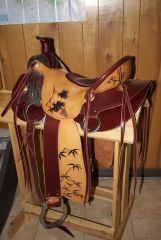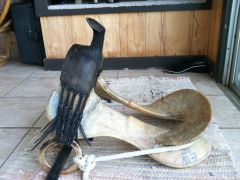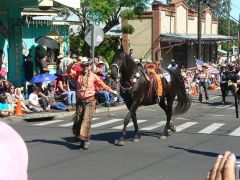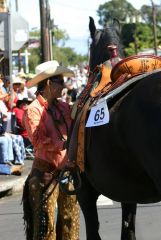
mauifarrier
Members-
Content Count
50 -
Joined
-
Last visited
Content Type
Profiles
Forums
Calendar
Blogs
Gallery
Store
Everything posted by mauifarrier
-
Great subject. I have made two stamps so far. This is my second one. It was a bugger to make, but the result is a nice 3D textured hibiscus flower. Stainless carriage bolt. Finished stamp measures about 1/2" I used various files, a carbon scribe and diamond coated bits in the dremmel tool Dont be afraid to try anything. Just do it in stainless, you'll be glad you did after investing all that time Aloha, Gretchen
-
I am also interested in whip making, so I purchased the How to make whips book on amazon for about $15. it came in a few days. There are some interesting strategies for cutting strands and using different types of leather detailed in the book. Personally I am using deer rawhide that I prepared myself, so that really keeps costs down. Will post a photo when finished. I hope others will do the same. Aloha, Gretchen
-
Dont mss the leather show every fall in Pendelton, OR. It's worth the drive. Sponsored by Ferdco, it's in November. Great place to buy used tools, pick up leather at bargain prices, and socialize etc. They also offer GREAT CLASSES on all sorts of subjects. I agree that Holster making will teach you many aspects of leather craft. Carving, pattern making, hand sewing, working with different finishes, etc. I recommend you subscribe to the Leathercrafter & Saddler's Journal as well as Shop Talk magazines. It's an inexpensive way to learn more about leatherwork and be continually inspired. The magazines also keep you abreast of events, etc. Oregon Leather co is a great store. Their scrap bin downstairs is full of good stuff, and you can buy Herman Oak scrap by the pound upstairs. I live in hawaii but when I visit family in the Portland area I ALWAYS go to Oregon Leather. Hand selecting leather sure is nice. Out here in Hawaii we usually have to trust the person on the other end of the phone, and there's some good folks out there to do business with. Aloha and welcome to the forum. Gretchen
-
Thanks in part to everyone's input on the subject of reata braiding in this forum, and with much reference to Bruce Grant's book, I completed my first Kaula ili. A Hawaiian style reata. It measures 35' because my shortest strand was 45' long. 1/4" wide strands. no core, mature steer hide. two strands dyed dark with coffee & rusty iron. It was good practice and I am eager to gather critiques and further information before starting another one in a few months. A note on the honda: The brass rope thimble is from the mariner influence in hawaiian ranching. Not only were the first cowboys sailors, but there were some decades of transporting the cattle by roping cattle and then riding horse and cow out to sea to an awaiting boat. You can buy teardrop shaped brass rope thimbles at Trick Roping Supply in Nevada, or round ones (to be compressed into oval shape) at most sail & marine stores. The brass has a nice weight when you swing and throw, but I'm a novice so I don't know much difference. Thanks in advance for the critiques... Aloha, Gretchen There wasn't much info in YouTube about reatas, so I made a video of the making of this one. the link is:
-
Do Feedlot Cattle Hides Make Inferior Leather?
mauifarrier replied to mauifarrier's topic in Suppliers
Thank you all SO much for contributing your thoughts. As a newer saddle maker (under 5 years) I was finally going to tackle an unusual saddle project and was ready to commit to top quality leather. I had placed my order after believing I had chosen a very good supplier and then started reading negative feedback about them (WC) as well as all the top sources. It just got me to thinking. Thanks! A young age makes even more sense than fat content in the skin. I'll post one more time after asking the folks at WC when I finalize my order. Shipping to Hawaii can require some creativity. Aloha, Gretchen -
On Of The Best Things I Found At The Tx Show!
mauifarrier replied to King's X's topic in Leatherwork Conversation
Heath, I bet the McClellan would be popular in full or half sizes. I know some ladies in the Netherlands who are fans of the Malibaud saddles (made on a McClellan type resin tree). One of the ladies wants to build her own saddle, and the Frenchman won't sell her a tree. (not yet, anyway.) I would love to steer their tree buying business to America if it wasn't too complicated. It seems the McClellan tree is useful to make iberian type saddles and classical/mideival type designs. I think a wither tracing would be good enough as these saddles have padded bars like an english or aussie saddle. Posting two photos of the trees, and in the background is a finished "spainish" type saddle marketed in Europe. The Iberian Connection imports a saddle called the Alta Escuela that looks like the saddle pictured in the background. I still can't figure out who makes this tree, but maybe it doesn't matter. *By the way, I have a half tree I bought from Heath and I used it to practice covering a tree with rawhide before I tackled a full size tree. These trees do not need rawhide at all, I just liked the small size for practicing this skill. I am very happy with it. Gretchen -
OK friends, I've been reading a lot of posts on the subject of skirting leather quality and where to get the best stuff. I can find positive and negative feedback about nearly all the primary tanneries and suppliers. Here's my question. Could the change in cattle farming over the past decade be any explanation for the "drop off" in quality? Even from the prominent tanneries like HO, WC, etc? I'm wondering if the hides on feedlot cattle are somehow fattier, or inferior from lack of exercise - diet - etc. I've read descriptions of mushy spots in hides, fat rolls, significant drop off in thickness, problems in the belly area, etc. Perhaps I'm grasping at straws, but if the hides are inferior before they even reach the tanneries, perhaps it's an explanation. I plan to ask WC next week as I finalize my order for some drum dyed black skirting. Out in Hawaii where I live, we have mostly grass fed beef. I make my own rawhide from deer, cow, and goat. I've experienced the difference between a fat or lean animal when making rawhide, especially with the deer. Thank you to each person who will share their thoughts.
-
Hidepounder I used to line my products with pig skin but have switched to calf. In my opinion it makes a higher end lining and I am able to provide some finger cut patterns in the calf that really sets off the interior. I am not oppossed to utiizing a quality pre-manufactured liner either. In my opinion it is better to use one of the liner kits like Chaynor-Fennelli makes than it is to try to construct a lining if you do not have the tools or the skills to make a proffessional grade lining. A good pre-fab interior can result in a higher quality product for less money. I can't begin to make an interior for what I can purchase one of those for. The limiting factor for me is that I may not be able to purchase the style or size that I want and I am unable to do any custom decorative carving to a pre-fab interior. Wow, thanks for the lead on Chaylor-Feneli liners. I checked out their new line of calfskin wallet liners and they are beautiful. Going to order a few from Hitching Post Supply. -Gretchen
-
Oh boy! That could further complicate things. Not to categorize them as good or bad, but flex trees are made by many different manufacturers and of varying types of materials. Ralide Blue Colored All Polymer tree. www.ralide.com Steele "Equifit EVO" Wood tree with Brown Polymer bars & groundseat http://www.steelesaddletree.com/evo.html Fits better (wood fork & cantle with black rubber bars) http://www.dynamitehorsemansupply.com/cart/index.php?main_page=product_info&products_id=315 If you do a search on this forum for "rubber bars" "Flex tree" etc you'll be able to read up on it.
-
Modifying A Saddle Tree, After It's Finished?
mauifarrier replied to HorseGirl98's topic in Saddle Construction
You can accomplish some amazing things with padding ingenuity. (or lack of padding in certain areas) Sounds like you've already nailed it, but otherwise the Pain Free Back & Saddle Fit Book Western edition by Joyce Harman DVM is a good buy. You can find it on Amazon. It cover's all aspects of saddle design, pads, fit etc. I think you'll really like it and will find yourself lending it out to friends when they encounter a fit problem Aloha, Gretchen -
Looks like a Buena Vista style Plantation saddle, but with a western front end. Unique and very cool! Hope it fits modern horses well. It should, those trees had bars with a decent amount of rocker & flare. It will be comfortable too, even if it puts you in a bit of a "chair" seat. Enjoy! I vote for Bee Natural products and Pure Neatsfoot oil.
-
Shortening Fenders/ Stirrup Leathers
mauifarrier replied to charliep's topic in Saddle Identification, Restoration & Repair
Great idea, Saddlebag! Thanks for sharing. -
OK Bob, I'll try to answer how I can within the limits of my experience to do justice on the subject. In Hawaii we have heat, humidity, and NO winter frost. Bacteria, fungus, mold, as well as flies, mosquitos, and termites have no off-season. We fly spray our horses all year round, deal with thrush, abscesses, and even "scratches" (fungal skin infection of lower legs) at any time of year. I was a farrier first, and saddlemaker/leatherworker second, so some of my notes show that influence. Saddles and equipment are under attack by mold, termites attacking the tree, and even from dust as the trade winds often blow 15+ mph daily. Your saddle sitting in a tack room can be accosted by scat from mice, roaches, or geckos. And rodents love to chew on rawhide. The pitfalls of over-oiling can include trapping fungal/mold spores into the leather. Some regions of the island seem to perpetuate mold in tack if it is stored and not used. I've seen folks use vegetable oil on older saddles and can not prove or detect that it ever went rancid, but after reading somewhere that it could, I cant get the warning out of my mind. I have a friend on the big island who uses a chest freezer to occasionally freeze saddles on purpose in order to kill termites lurking within the tree. The lack of fleece in the skirting is unique to our hawaiian saddles. There were two main reasons a saddle did not have fleece in hawaii and both have to do with water. For decades, the cowboys had to "swim cattle" out to boats that would take them to Honolulu for market. This meant roping the steer and plunging into the ocean until horse & steer were both swimming out to meet a small boat. The small boat would lash the horns to the rail and then paddle the cattle to the bigger boat waiting further out in the bay. I'll try to attach a photo or two to satisfy curious eyes. For swimming cattle the saddle would be stripped of all leather possible. Our rigging is made of braided rawhide and brass rings because it held up much better to the salt water. The second reason for no fleece is for riding and working in rainy weather. Fleece would simply act like a sponge and not dry out. The hawaiian saddle is held together with saddle strings and can be disassembled, repaired, or stripped down easily by the Paniolo (cowboy) who owned it. Living on an island forces residents to make due with what's available locally. Many older hawaiian saddles are blackened by the used machine oil from the Sugar & pineapple mills. That's right, they used the discarded machine oil (transmission, gear oil etc) to oil their leather. It imparts a funny smell and a dark color. Probably not the best thing for the leather. As I build my saddles, I've called them Hawaiian "style" rather than authentic/historic Hawaiian. I've tried to blend the old with some new technology and design comforts for a recreational rider. Using a modern tree to fit a modern horse's body shape is also important. I buy leather from the mainland and Bee Natural products to get things off to a good start. The Saddle Oil with fungicides is a proprietary blend. I don't know what's IN it, but I would guess mostly pure Neatsfoot oil with maybe some anti-microbial "essential oils". Just a guess. If the owner of Bee Natural ever wanted to reveal it, I'd be all ears. I'm very happy with the stuff, and nothing has molded that I've made with it. Not that I know of. But I've only been doing leatherwork for a few years. My next project is to restore a 100+ year old tree. It is handmade of local wood, damaged by termites, and needs to be re-covered with rawhide. I'll be lacing it up with goat rawhide because that's what they used back then. As that project progresses, I'll update my profile and website with photos. A few photos attached for fun...
-
Shortening Fenders/ Stirrup Leathers
mauifarrier replied to charliep's topic in Saddle Identification, Restoration & Repair
I agree with Saddlebag in the necessity of doing this. I usually remove 3" of fender, and have done it to three different saddles belonging to short legged riders. I'm a huge fan of the "twist", but sometimes it bumps the fender up higher above the stirrup and necessitates trimming all the more. Dusty Johnson's lovely $20 book on saddlemaking instructs you how to to the twist by building a cuff of leather and lacing it up tight. If you don't already own his book, it's very handy and informative for the money. A useful reference even for making repairs or replacing parts on a saddle. -
Love this forum because there are so many great ideas. I have read that vegetable oils can go rancid. I have certainly experienced that with Crisco in my cupboard here in Hawaii where it's hot. I have also read cautionary tales against Murphys Oil soap on leather. However, I have tried Murphys on a deer raw hide I was working with and I liked the results. What makes the shine? A wax product. Leather Balm with Atom wax, bee natural, any of those I would be willing to spend the extra $$ for products formulated and sold for use on leather. Bee Natural products are wonderful, their saddle oil with fungicides is great. I use their products on all new leatherwork I do. If you don't want to buy their products at retail, then piggyback onto a friends Weaver Leather order and you'll access them at wholesale price. If the leather is black, you won't worry much about oils or waxes darkening it. Clean it, oil it, and after all that dries a day or so, try Fiebibing's Leather balm with Atom wax. I think that would be the cheapest, and you'll get a nice shine. Good luck! It was fun to read everyone's contribution. Gretchen
-
I sure do appreciate your website resource, as I've already said other times before. Thanks, Rod & Denise! Tom, you have us so curious now as to what this saddle looks like, could you please entertain us with a photo EVEN IF you DONT decide to work on it? I had a request the other day to entertain a saddle repair where the horse was tied to a tree and bolted forward hanging the horn & fork up on a branch, tearing the rigging apart. It was a Carl Ammerman barrel saddle, which retails at $2,000 or less. I advised they ask the "Manufacturer" about repairs first. Also pointed out there may be tree damage due to such a strain on the saddle. A wise saddlemaker once told me to avoid doing any changes or repairs to saddle rigging because of liability. The rigging is what holds the saddle onto the horse, so if you're the "last person who touched it" and the rider/owner gets in a wreck, they may hold you liable. You may have more "fun" building a saddle from scratch than trying to fuss with a mass produced saddle full of glue, nails, & staples. Once you've built a saddle you'll also feel much more familiar with saddle repairs. However, the materials cost to build a saddle may add up to more $$ than your friend wants to invest if she's used to buying production line saddles. Best wishes!
-
Wow, that is really classy. Top notch. Thanks for the preview photo!
-
Rod & Denise Nikkel also do replacements. Their work is supreme. I viewed their blog last night and it was really interesting about tree replication. Check it out: http://www.rodnikkel.com/content/index.php/saddle-tree-blog-from-shop-and-desk/duplicating-trees-part-1-taking-them-apart/
-
Oh, and regarding ground seat details, with Steele's EVO tree, they have a built in ground seat. Made of the same material as the bars. It's all connected. (I don't know how that compares to the FitsRight tree mentioned in the other thread.) You glue your layers of leather against it and skive away to further shape things from there. I wonder if the production made saddles on trees like this have any additional leather over this ground seat at all. Who know's? But with the rigidity of the material, the leather seemed to bond fine with the glue and stay put. Heath Howe's trees (literidetree.com) also have a built in ground seat. It "bridges" the bars with a slot for the stirrup leathers to pass through. It looks like new technology is here to stay. Not all of it will be good. Rubber bars (of the FitsRight) sound very bad. There are probably more Flex trees that Flex TOO MUCH than one's that are mostly rigid. I'm a farrier, and there is the same trend in the shoeing industry. You can always rely on the tried and true. But some customers will demand the fancy techno stuff. It's a personal choice whether or not to take the risk and play with the new inventions. No one is twisting our arms to try it.
-
I have worked with the EVO tree by Steele. It was to build a Trail Saddle. The finished saddle is actually the first one that I've completed. The tree barely flexes at all. You have to put the tips of the bars on the ground and lean against it really hard to feel perceptible movement. The color of the EVO is brown, they also make a flex tree with Black color, and I do not know which one is MORE flexible, but I would guess the Black. Since then I've built on wood trees, but did order another EVO tree to build a Portuguese style saddle as a muse. I was content building on it, but I can tell you how it went AFTER the saddle was finished and a friend used it on her horse. We were trying to fit a hard-to-fit horse. A short QH with tiny feet, short back, and a 180lb female rider that needed a 17" seat. Typical scenario of an overweight rider selecting a small or short horse to ride on trails. Makes mounting and dismounting easier, but not compatible otherwise. This horse had worn a series of saddles that clearly did not fit. Usually the bars were too long, causing pressure over the weakest part of the horse's back. Pete Gorrel's book on saddle fit makes a point of this challenge for saddlemakers. The mare had muscle atrophy behind the shoulder blades. I selected this tree and checked it against the horse before building on it. Then when the saddle was finished, it put uneven pressure on the horse's shoulder initially because of the atrophied pockets behind the shoulders. I built temporary shims to fill this void and within a month or two, the horse had a well muscled back and we could go without the shims. The horse looked great, but was quite fussy about the saddle. Perhaps it was the flex properties, the shorter bars under a 17" seat, or the fact that the mare had such a history of back pain that things were chronic even with a well fitting saddle. In the early spring to keep weight on the horse she overfed it "hot" feeds and got bucked off one morning. She blamed the saddle (and me as it's maker) for everything. Very awful situation between friends. She sold the saddle to someone else who loves it but doesn't ride as often. In conclusion, I would say the Steele EVO tree is not overly flexible. As a company, I like their measuring system with their fit forms that you can try on the horse. Their wood trees have received criticism in the forums here, and are in no way an apples to apples comparison with handmade, hand finished trees. For their price point, with the FTBS saddle fit measuring system, I think you can buy a tree (wood or Flex) and anticipate how it will fit for a fairly low amount of money. And to his credit, Ed Steele is personable, helpful, and will provide all the customer service you could wish for. I hope this helps, click on this link to see a few photos of the tree, and saddle that I made with the flex tree: http://www.mauifries...xible_Tree.html Gretchen
-
Precision Saddle tree co advertises that they can repair trees or even copy them. Check out their website: http://www.precisionsaddletree.com/treerepair.shtml
-
A simple start would be to buy the Encyclopedia of Rawhide and Leather Braiding by Bruce Grant. Available new or used on Amazon
-
I thought for sure that by now there would be many iPad covers, or even a tutorial on how to make one in Leathercrafter & Saddler's Journal. Surprisingly, not that many. So if you do make one, why not photograph the steps and submit it to ShopTalk or The Leathercrafter & Saddler's Journal? My husband has an ipad, but he uses a waterproof/shockproof case made by otterbox because he has a beach business. If you look online at Amazon you'll see all the cheaply made cases & covers. There really is a place for a hand made tooled case. Good Luck!
-
Half Trees Or Mini Trees
mauifarrier replied to Chi Stockyrd Saddle Tree's topic in Leatherwork Conversation
Sorry, had technical difficulties posting from my phone. (above) Wades seem to still be SO popular, I wonder if folks would want wade half-trees. I bought the Lark Bunting for a project and am really happy with it. I covered it with rawhide just for the practice. (The tree doesn't NEED it, but it was easier to practice on than a full sized tree.) I plan to finish it as a scale model or replica sort of saddle for travel at shows, etc. This size tree makes a nice display saddle for your tabletop at a leather show or fair. Saves space and would be easy to pack. I also recommend buying one of these trees in order to become oriented with the material they're made of. I originally found Heath and his tree company because I was looking for Portuguese style tree sources, which are very limited. Hope to make a portuguese style saddle in 2012 Aloha -




